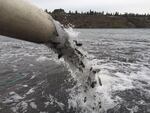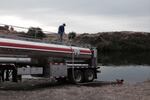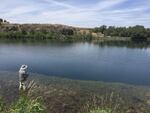
A stream of thousands of steelhead plop out of a tanker truck and into Washington's Rock Lake.
Courtney Flatt, NWPR/EarthFix
A stream of thousands of steelhead plop into Rock Lake. In this final leg of their journey they fall out of a tanker truck and into the lake. To get here the fish have traveled seven hours in tanker trucks from Puget Sound, over the Cascade Mountains, and into the Eastern Washington desert.
“This lake is real nice and deep, so it won’t take them long to find some lower depths and find some cooler water,” said Brian Russell, who is leading the team stocking Rock Lake.
In about three minutes the steelhead are dumped from the tanker and are swimming near the shore. Fish jumping all around. A few accidentally swim onto the banks, and workers toss them back into the lake.

A semi releases Puget Sound steelhead into Rock Lake.
Chet Dixson
These fish were supposed to end up in a river heading to the ocean, not an inland lake. Why they ended up here is a longer story.
It started with a lawsuit.
"There seems to be this common misconception that there really is not difference between hatchery fish and wild fish," said Jamie Glasgow, an attorney with Wild Fish Conservancy.
The advocacy group argues that hatchery fish are in fact harming wild populations. Glasgow said one main concern is the differences in wild and hatchery fish genes, which, he said, can disrupt the timing of runs, where fish spawn, even how they look.
Glasgow offers an analogy to explain: wolves versus golden retrievers. Imagine what would happen, he said, if wolves and domesticated retrievers bred in the Cascades.
"The offspring of that pairing would also have reduced fitness and reduced ability to survive in the wild," Glasgow said. "It wouldn't be as bad as the pure Labrador, but it wouldn't be as good as the pure wolf. And that's exactly what we're seeing with steelhead. It's what the science is telling us."
Based on that, the Wild Fish Conservancy sued to keep hatchery steelhead out of most Puget Sound rivers — pending a review of each hatchery program.
The conservation group won.
Now federal officials are conducting a full-scale environmental analysis of Puget Sound steelhead hatcheries.
That has Chris Donley fuming.
"It was really making the best out of a bad situation at this point," said Donley, the Washington Department of Fish and Wildlife's inland fish program manager.
Donley said it's a bad situation because Puget Sound anglers are losing out on fisheries. But more importantly, to Donley, the department may lose these Puget Sound hatcheries. It's been two years since the department has been able to release most of these steelhead into rivers.
"We're sitting in a situation where the last set of eggs we're going to collect was this year," Donley said. "Those brood fish are on station. If we don't get a permit to release those, it's going to be very difficult to keep those programs going."
National Oceanic and Atmospheric Administration officials said they received thousands of comments on a draft environmental assessment.
Rob Jones, who oversees hatcheries for NOAA fisheries, said hatchery science is evolving quickly, and that's why these hatcheries need a review process.
"It was pretty clear to us that these early winter steelhead programs, there's really a lot of debate about them," Jones said.
This is the first time early winter steelhead hatcheries in Puget Sound have been put under this review.

Chet Dixson fishes at Rock Lake in Eastern Washington. Rock Lake is the largest natural lake in the state and is now being stocked with Puget Sound steelhead.
Courtney Flatt, NWPR/EarthFix
While the scientists debate, Eastern Washington anglers, like Chet Dixson, are taking advantage of the newly stocked fishery.
"It's good fishing here most all the time. I've got one on now. It's just a little guy," Dixson said.
Managers say the new fish will be better catching this fall. Right now they're about 6 to 8 inches long, but they're expected to double in size.
Later this summer NOAA is holding public meetings about the environmental assessment of Puget Sound hatcheries.
